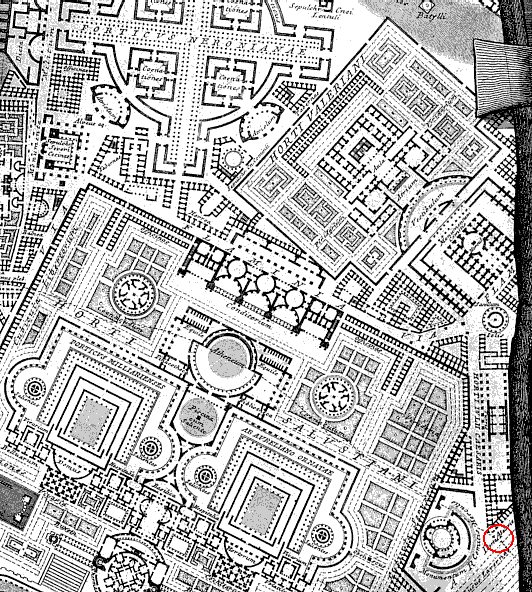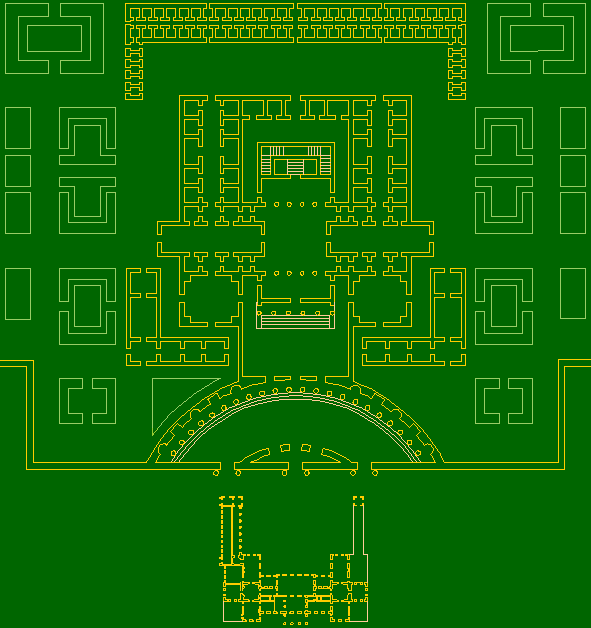Domus Valeriorum. There was on the CŠlian, between S. Stefano Rotondo and the Lateran, a palace belonging to the descendants of the Valerii PoplicolŠ, namely, to Valerius Severus, prefect of Rome in A.D. 386, and to his son Pinianus, husband of Melania the younger. The palace was so beautiful, and contained so much wealth, that when Pinianus and Melania, grieved by the loss of all their children, put it up for sale in 404, they found none willing to purchase it: "ad tam magnum et mirabile opus accedere nemo ausus fecit." Seven or eight years after the capture of Rome by Alaric, August, 410, the same palace was given away for little or nothing, "domus pro nibilo venumdata est," having been "dissipata et quasi incensa" by the barbarians. There must be some inaccuracy in this account, which Commendatore de Rossi has found in a MS. of the library of Chartres. In the first place, a considerable part of the property was transformed into a hospice and a hospital under the title of "Xenodochium Valeriorum" or "a Valeriis," which flourished until the ninth century, and the transformation must have been the work of Pinianus himself and not of an outsider. In the second place, the house was discovered in 1554, 1561, and 1711 in such a wonderful state of preservation that we must exculpate the Goths from the charge of having pillaged and gutted it in 410.
Rodolfo Amedeo Lanciani, The Ruins and Excavations of Ancient Rome (1897), p. 345.
DOMUS VALERIORUM: on the Caelian, on the site occupied now by the Ospedale dell' Addolorata, where many remains of pavements, frescoes, and works of art have been found, and eleven inscriptions relating to the family in the fourth century. This house was offered for sale in 404 A.D., but found no buyer on account of its magnificence, while six years later, after the sack of Rome by Alaric, it was sold for almost nothing. It seems to have been transformed into a hospital--Xenodochium Valeriorum or a Valeriis. (Platner)
Vincenzo Fasolo, "The Campo Marzio of G. B. Piranesi".
2691a
1956
Visigothic seige
"Thus began the third Visigothic siege, actually blockade, of Rome, an event whose outcome, after some eight centuries in which the imperial City had known impunity from foreign foes, created a shock of horror from Bethlehem to Britain. Once again Gothic bravery found itself daunted by the walls of Emperor Aurelian; the treachery that the Romans had feared in the beginning of 408 now in fact admitted the Goths by the Salarian Gate, 24 August 410, but not before the City had once again felt the bite of famine. Some buildings were burned, notably the Palace of Sallust the historian, which stood in its magnificence gardens near the gate of entry, perhaps the Basilica Aemilia in the Roman Forum, and the Palace of Saint Melania and Pinianus on the Caelian Hill, then one of the most fashionable quarters of Rome. Palaces and temples were plundered, some persons were slain or tortured to reveal their presumed hidden wealth; some virgins and other females were raped, but churches, especially the basilicas of Saints Peter and Paul, were spared and made places of refuge."
Stewart Irvin Oost, Galla Placidia Augusta: A Biographical Essay (Chicago: The University of Chicago Press, 1968), pp. 96-7.
| |
Campo Marzio discoveries
2004.03.18
2. the circle/square Porticus Neronianae marks the spot of Alaric's Visigoth camp prior to the (primal) break-in at the Porta Saleria. The 45 degree marks of the Porticus Neronianae marks the four cardinal points. Since the compass of the Ichnographia matches the center of the Porticus Neronianae in size, perhaps Piranesi is here indicating the spot where the "winds" shifted--the historical winds. I now know how the Nolli map corresponds with the Campo Marzio area of the Celian Hill/Horti Salustiani. Platner provides an interesting history of the "Domus Valerianus"--nobody bought it in 404 AD; it sold for almost nothing after Alaric 410 AD; it appears to have become a hospital (which makes sense with regard to Melania's mission.
Re: crossology
2004.04.01 12:47
Not too long ago, countable days actually, I first learned of Melania the Younger, and how her husband's (enormously expensive) family estate [Horti Valeriani] just outside the walls of Rome at the Salarian Gate, was one of the great properties (along with the Gardens of Sallust) that were plundered when Alaric and his Visigoths broke into (at the Salarian Gate) and sacked Rome for the first time. The Visigoths initially camped for many months outside the walls of Rome (near the Salarian Gate) thereby starving the city by disrupting all deliveries of grain from Africa to the city. The Salarian Gate, the Gardens of Sallust, and the Gardens Valeriani are all delineated within Piranesi's Ichnographia Campus Martius right where they are supposed to be. Interesting, right next to this complex of buildings/structures, Piranesi also delineates a Porticus Neronianae, a completely fictitious building in the shape of a large cross within a circle (a composition, coincidentally, that follows the circle/square juncture pattern similar to the Timepiece gauge of the theory of chronosomatics). Within a day of assimilating all this new data, I came to see how the inner circle of the Porticus Neronianiae matches the circle of the compass/north arrow that Piranesi also delineated within the Ichnographia, and I came to see how if you rotate the cross of the Porticus Neronianae 45 degrees, its four points then correspond exactly to the four cardinal points of global direction. The Porticus Neronianae of Piranesi's Ichnographia Campus Martius is the X that marks the spot where the first attacking Visigoths camped. [There are even more 'symbols' to interpret here, like 'shifting winds' and Nero as anti-Christ precursor, but more on that latter.]

Giovanni Battista Piranesi, Ichnographia Campus Martius (1762), detail.
The Horti Valeriani is situated in the upper right corner, directly above the Horti Sallustiani, which occupies the entire bottom portion of the plan. Note that the Aurelian Wall is delineated via a bowing dotted line, which is visible directly above the words 'Horti' and 'Sallustiani'. The position of the Salarian Gate is indicated along the dotted line, here circled in red.
scale comparison
2004.04.08

Scale comparison between the Horti Valeriani as rendered by G.B. Piranesi within the Ichnographia Campus Martius and Whitemarsh Hall formerly at Wyndmoor, Pennsylvania as designed by Horace Trumbauer.
|


